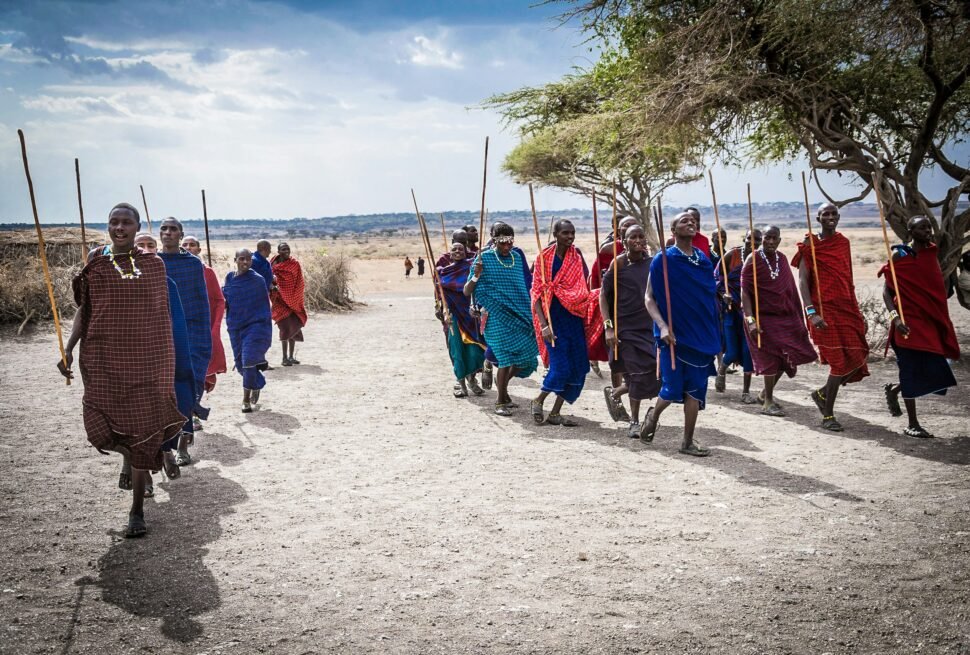When most people envision a safari in Tanzania, their minds naturally come up with images of the vast savannah, the majestic “big five,” and the beauty of the Serengeti. while the wildlife and landscapes are truly breathtaking, there is another equally captivating aspect of a Tanzanian —the rich and diverse culture in Tanzania. engaging with local communities can deepen your experience, providing you with not only unforgettable memories but also a profound understanding of the cultural traditions and social practices that shape life in this part of
The cultural diversity of Tanzania.
Tanzania is a country defined by its cultural diversity, with over 120 distinct ethnic groups, each with its own unique traditions, languages, and practices. these communities co-exist peacefully, which is a testament to Tanzania’s long-standing history of unity and harmony despite its rich ethnic mosaic.
Some of the most prominent ethnic groups include the Maasai, Chagga, Sukuma, and hadzabe. each group brings a unique flavour to Tanzania’s cultural landscape:
The Maasai: Perhaps the most well-known of Tanzania’s ethnic groups, the Maasai are semi-nomadic pastoralists who have largely resisted the influences of modernization in Favor of preserving their traditional way of life. Known for their brightly coloured Shuka’s (red robes), intricate beadwork, and deeply spiritual connection to their cattle, the Maasai continue to live in villages that dot the plains near famous safari destinations such as the Serengeti and Ngorongoro crater.
The Chagga: living on the fertile slopes of Mount Kilimanjaro, the Chagga are skilled agriculturalists, cultivating bananas and coffee as their primary crops. visitors to Chagga villages often get a chance to learn about their farming techniques, as well as the elaborate irrigation systems they have maintained for centuries. Chagga culture is also defined by a strong sense of entrepreneurship, with many members involved in trade and commerce.
The Sukuma: Tanzania’s largest ethnic group, the Sukuma people reside primarily around the southern shores of Lake Victoria. traditionally, they are known for farming and cattle herding. in Sukuma culture, traditional medicine plays an important role, and visitors may be invited to observe local healers at work, practicing age-old techniques passed down through generations.
The Hadzabe: one of the last remaining hunter-gatherer communities in Africa, the hadzabe live near lake eyasi in northern Tanzania. unlike the Maasai or Sukuma, the hadzabe have maintained their ancient ways of subsistence hunting, gathered wild fruits, and lived in harmony with nature. their deep knowledge of the local ecosystem is fascinating, offering insight into a lifestyle that has existed relatively unchanged for tens of thousands of years.
EXPERIENCING THE COMMUNAL WAY OF LIFE
When you visit local villages during your safari, you’ll quickly notice the communal way of life, where people work together in fields or engage in collective activities like farming and herding. this cooperative spirit is central to many Tanzanian communities, where extended families and entire villages often share responsibilities and resources.
Agricultural activities: farming is the backbone of rural Tanzania, and many communities depend on agriculture for their livelihood. villagers grow crops like maize, millet, and cassava, while also tending to livestock such as goats and cattle. visitors may be invited to participate in daily tasks such as planting, harvesting, or milking cows. engaging in these activities not only provides a hands-on experience but also offers a deeper appreciation for the hard work and dedication that sustains rural communities.
Grazing and herding: for groups like the Maasai and Sukuma, cattle herding is more than just an economic activity; it is a way of life. cattle symbolize wealth, status, and social ties. when visiting these communities, you might witness herdsmen leading their animals across the plains, often covering great distances to find fresh grazing land. understanding the relationship between these herders and their livestock provides insight into their deep connection to the land.
INSIGHTS INTO SOCIAL STRUCTURE AND TRADITIONS
A key part of experiencing Tanzanian culture is understanding the social dynamics that shape everyday life in these communities. village life is organized around traditional leadership structures, often led by elders or village councils. elders hold a revered position in Tanzanian society, acting as custodians of knowledge and mediators in disputes. their wisdom is sought in important decision-making processes, from land distribution to family matters.
ceremonies and rituals are also central to community life. whether it’s a Maasai warrior’s initiation, a Chagga wedding, or a Sukuma harvest festival, these events are imbued with
deep cultural significance. visitors may have the opportunity to participate in or observe traditional ceremonies, which often feature dancing, drumming, and storytelling.
Ceremonies. Many ethnic groups in Tanzania have complex initiation ceremonies marking the transition from childhood to adulthood. for example, among the Maasai, young men undergo a series of tests, including circumcision and a period of living in isolation, before being accepted as a complete warrior. these rites are deeply spiritual and provide insight into the Maasai worldview, where bravery, resilience, and loyalty are highly valued.
Traditional dance and music: music and dance are integral to Tanzanian cultural expression. different communities have their own unique musical styles, often using traditional instruments such as drums, flutes, and stringed instruments. the Maasa, for instance, are known for their “adumu” or “jumping dance,” which is performed during celebrations and warrior ceremonies. The Sukuma are famous for their acrobatic dance performances, often featuring dancers dressed as animals.
LANGUAGE AS A GATEWAY TO CULTURE.
Swahili, Tanzania’s national language is a unifying force that connects the country’s diverse ethnic groups. While most Tanzanians speak their ethnic language at home, Swahili is the language of commerce and government, making it an essential tool for communication across the country. For visitors, learning a few basic Swahili phrases can be an excellent way of interacting with the societies and show respect for the local culture.
Simple greetings like Jambo (hello), Asante (thank you), and karibu (welcome) go a long way in creating a warm rapport with the people you meet. Tanzanians are known for their hospitality, and attempting to speak Swahili, even if just a few words, is often met with smiles and encouragement. Some communities may even invite you to engage in language lessons or storytelling sessions, where you can learn more about Swahili proverbs and sayings that reflect Tanzania’s cultural values.
For example, the Swahili phrase “haraka haraka haina baraka” translates to “haste has no blessing,” encapsulating the Tanzanian attitude towards patience and taking things at a measured pace. embracing these linguistic words helps you connect on a deeper level with the people you encounter during your journey.
TRADITIONAL TANZANIAN CUISINE: A CULINARY JOURNEY
No cultural experience is complete without savouring the local cuisine, and Tanzania is no exception. Tanzanian food reflects the country’s diverse heritage, with influences from Indian, Arab, and African culinary traditions. While the staples of Tanzanian meals may vary from region to region, some common dishes are enjoyed throughout the country.
Ugali a starchy dish made from maize flour, ugali is a staple in Tanzanian households. it is typically served with meat stews, vegetables, or fish, and eaten by hand. ugali holds a central place in Tanzanian culture, symbolizing nourishment and unity, as meals are often shared communally.
Nyama choma literally meaning “grilled meat,” nyama choma is a favourite among Tanzanians, especially during celebrations or social gatherings. goat and beef are commonly grilled over an open flame, seasoned simply with salt and served with accompaniments like kachumbari (a fresh tomato and onion salad) and ugali.
Chapati and samosa: Influenced by Tanzania’s Indian heritage, chapati (a flatbread) and samosas (Savory pastries filled with meat or vegetables) are popular snacks and side dishes. you can often find them being sold by street vendors in bustling markets.
spiced dishes from Zanzibar if your safari extends to the coastal regions, particularly Zanzibar, you’ll encounter dishes infused with fragrant spices such as cloves, cinnamon, and cardamom. Zanzibari cuisine features seafood, rice, and exotic fruits, creating a vibrant fusion of Flavors that reflect the island’s historical role as a trading hub.
THE WARMTH OF TANZANIAN HOSPITALITY
One of the most rewarding aspects of engaging with Tanzanian culture is the incredible warmth and hospitality extended to visitors. Tanzanians are known for their open-heartedness, and it’s common to be invited into homes for a meal or to participate in family celebrations. this hospitality is deeply rooted in the concept of “ubuntu,” an African philosophy that emphasizes communal bonds, shared humanity, and mutual respect.
whether you’re visiting a bustling market in arusha, exploring a Maasai village, or spending time with a Chaga family on the slopes of Kilimanjaro, you’ll likely experience the genuine
warmth and generosity that defines Tanzanian hospitality. these interactions offer a window into the values of community, family, and mutual respect that are at the heart of Tanzanian culture
CONCLUSION
As you embark on your safari in Tanzania, take the time to explore and appreciate the rich cultural traditions that define this beautiful country. From its diverse ethnic groups and vibrant music to its delicious cuisine and the warm hospitality of its people.




